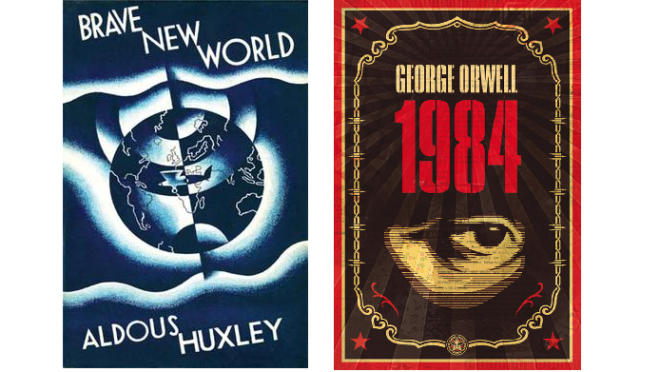Brave New World vs 1984: Stability but at what cost?
Brave New World vs 1984: Stability but at what cost?

The dystopian novel ‘Brave New World’ by Aldous Huxley is considered a classic and often regarded as the counterpart to George Orwell’s ‘1984’. Both books tell us stories of future societies where things are quite different from the world we know but at the same time invoked the question- “is it really different or is it the same but we just don’t see it clearly yet?”
Orwell’s 1984 talks about a society where “Big brother is watching you” all the time and if you do anything that goes against the script of Big Brother, then you are doomed. Pain and torture work as the ultimate control mechanism in this world. “If you want a picture of the future, imagine a boot stamping on a human face—forever” – a line from the book pretty much sums it up.
Brave New World handles things a bit differently. Huxley starts the story with a bit of a confusing tone where it takes a few pages to introduce us to the world and how it works. But then it starts to pick up quickly. Contrary to 1984, pain is not the controlling force here but the authorities or in the case of this story, ‘Ford’ uses pleasure to make sure everyone does their part in this world, for everyone has a role to play which ensures that the society runs smoothly.
“Everyone belongs to everyone else.”
But the real twist comes when we raise the question of freedom. In 1984, there was no freedom and pain will ensure that. “In the face of pain there are no heroes.”
In Brave New World, the institutes determine who will play what role and then breed the members of the society accordingly. In this world, human beings are no longer born naturally rather cultivated according to the needs of the society. Everyone is born with a predetermined role for them and they are conditioned according to their future role. It’s the ultimate form of control. “One believes things because one has been conditioned to believe them.”
There are different castes in this society and each caste has a different role in the society. They are given their rewards according to their social status. Perhaps the most eye-catching element in this world is the ‘Soma’, which is a drug in the form of a pill that is given out in rations to keep everyone in line. If someone is acting out, they will not get their soma ration for the day and people will do almost anything to get soma.
‘Soma’ gives people a pleasant trip that keeps them away from the harsh reality.
“What you need is a gram of soma.”
“Take a holiday from reality whenever you like, and come back without so much as a headache or a mythology.”
While there is so much more to Brave New World, the world depicted in this story is something to think about. Interestingly, even though a few decades back it would have been considered a horror depiction, todays’ readers have started to feel differently about this book.
“It seems like the world in Huxley’s Brave New World is a pretty ideal society. Is it fair to call it a dystopian novel?” asked one reader on Quora which sparked a discussion and revealed the true genius of this book- it seems great on the surface but at what cost?
Both 1984 and Brave New World, behind the veil of their storytelling, asks us an important question- “what is the price of freedom and are you willing to pay that price?” Again, and again, in different forms, one thing becomes crystal clear in both of these stories- stability is the price of freedom.
If a society is free, then stability will be difficult to achieve. So, one has to make a choice, do you want a volatile society that celebrates freedom and spirit? Or do you want progress and stability at the cost of free will?


